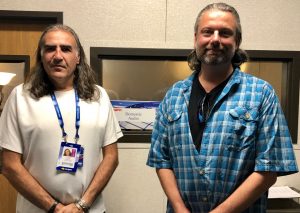Live From the US Open: ESPN’s Big Audio Deployment Includes an Atmos Test
Story Highlights
Somehow, among the 50 dedicated audio personnel and nearly countless microphones deployed across nine feeds and venues — each with its own mix console, for a total of nine Lawo mc² 56 desks — ESPN is managing to test Dolby’s Atmos format for tennis during the lengthy and complicated D-Day landing that is the annual US Open in Flushing, NY.
“It’s an experiment, but it’s also a demonstration, to show we can do it, that the technicians can handle it, that we’re monitoring correctly, and that we can set it up in different environments and still know what the final product will sound like,” says Florian Brown, ESPN’s audio supervisor for all of the broadcast sound for the Open, which runs from Aug. 26 through Sept. 8. “Then there’s the output: are we sending the 5.1.4 or are we sending the downmix? There’s a lot we have to figure out. But as the video moves to 4K and even 8K, the audio is going to have to keep up. That’s what we’re getting ready for here.”
They have to do that while still getting the conventional 5.1 feeds to ESPN’s domestic outlets, as well as to international feeds as the host broadcaster. Brown and his immediate staff, including supervisor Leonard Fisher, are working on Atmos from part of the second-floor audio control room, covering the Arthur Ashe Stadium, Louis Armstrong Stadium, and the Grandstand main venues, as well as from a number of other venues used for announcing and interviews. The Atmos audio is not going to broadcast, or even to ESPN’s Bristol, CT main facility. Instead, it’s being recorded to Avid Pro Tools, through a Lawo, mc² 56 console, and playback will be through a number of monitoring configurations — Atmos’ signature four-speaker overheard array is attached to scaffolding installed for the purpose — and a Sennheiser AMBEO soundbar.
Atmos is pulling from the array of effects microphones deployed for the Open, as well as additional dynamic mics placed in different tiers of the stands for the Atmos tests, looking for the best locations to pick up the Open’s often boisterous crowd in New York.
“It can get pretty noisy when the roof is closed, as it has been for much of the time here,” says Brown. “We placing mics at the top, the mid tier and the lower tiers of the stands, looking for the best spot.” A Sennheiser 3D AMBEO multichannel microphone, provided by Dolby, is also deployed, just above the announce booth at the Arthur Ashe Stadium.
Brown says the idea of immersive audio is still new, and that goes more so for tennis, so where elements should be placed in the mix and how they should move within it is a work in progress.
“There are no norms for this yet,” he says. “Fortunately, we have a lot of time to try things, and we have a huge group of people, not just audio but video and operations people and everyone else, who can give us plenty of input.”
Nine Consoles, No Waiting
The gear used for the Atmos tests, as well as all of the rest of the audio equipment on site, was provided by Gearhouse. That includes Alteros’ GTX Series L.A.W.N. Ultra-Wideband (UWB) wireless microphone system. The GTX operates in the 6.5-GHz range, which Brown says helps enormously in the New York area’s notoriously constricted RF environment, which has gotten even tighter in the last two years with the loss of most of the 600-MHz spectrum. That 6.5-GHz spectrum is also free of FCC regulations; however, that freedom comes at the cost of power: additional antennas, to keep RF devices within about 90 feet and with a clear line of sight, are necessary. But given the city’s RF landscape, Brown says the tradeoff is fine.
As noted, the US Open is a combination of noisy crowds in highly ambient environments. Players have long groused about the chatter of fans, especially in the upper seats, where the curved roof amplifies and distributes that noise like a reverse parabolic collector. Brown is using a number of Waves plug-in processors with the Lawo consoles to mitigate some of that, including the WNS and NS1 noise-suppression processors. These help isolate external noise intrusions, such as nearby subways and airplanes departing close-by LaGuardia airport.
On the other hand, says Brown, the fan chatter and the ambient sounds are simply part of the event that ESPN is there to document. What a superstar tennis champ might find distracting is an integral part of the soundscape for sports in the Big Apple.
“In France, it’s the wind; in Australia, it’s the heat; in New York, it’s the noise,” says Brown.
As any New Yorker would say, it’s always something.

